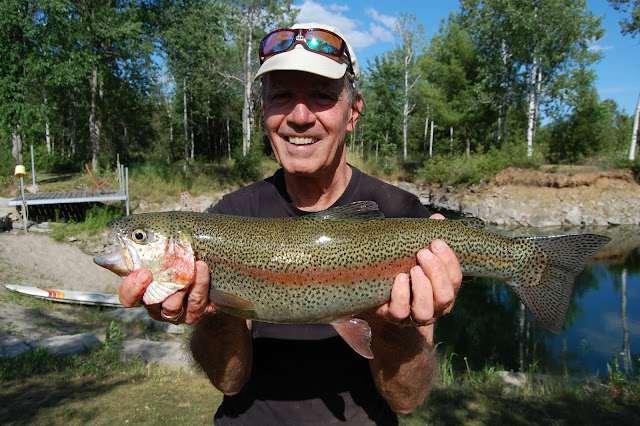Planting trout in the pond begs the question of natural reproduction in the pond. There isn't any. Two reasons for this. First - trout need well aerated and moving water (like a creek) at the right temperature across their eggs for the eggs to mature properly and hatch. Also they need a suitable substrate like gravel to stimulate the mating and egg laying, which also isn't available in the pond. The fertile fish do try mating on the rocky shore if it is underwater in November (fall spawners; genetically determined). Second - many fish farm breeders are now briefly thermally shocking their fertile trout eggs in hatching trays, which renders them sterile after hatching. In Quebec this is the law. In this way, escaped fish cannot breed in the wild. A great idea really. I used to breed fertile trout and hatch thousands in one of my labs at Carleton University for research and planting, but that's another story.
As you can see below, the fingerlings from the Cedar Creek farm are put into a plastic bag, and then the air is removed and replaced with pure oxygen. This allows them to be transported for 3 or more hours without an oxygen debt, especially if they are kept cold.
As an example of how active they are at this age and size, I add a very brief video taken by Nancy just before the trout were released into the pond. If your audio is on, you will hear noisy the fish can be.
Not all of the fish swim away immediately. Several rest on the bottom for 15-20 min before joining the others in their new home. The new fingerlings will have to provide for themselves, as I only present commercial food to the older fish (3 and 5 year old), and only a couple of times each week in the spring, early summer, and fall. As the pond ages, they find more and more natural food, including nymphs of all kinds (mayflies, caddis flies, etc.), frogs, leeches and minnows (stickleback and dace). All but the dace appeared in the pond spontaneously! Isn't Mother Nature wonderful.
And thus, another successful introduction....
Over time, as the fish grow, they quickly get used to the bi-weekly feeding ritual. I always start throwing out commercial food pellets from the berm near the middle of the pond and continue as I walk back toward the house and dock. This allows me to sit on the dock and watch the feeding fish as they follow the food trail to the dock, where I can enjoy their revelry. My daughter Tobi has captured this activity in the 2 min video below.
The manner in which we remove trout from the pond is normally by fly fishing. It is a real treat to land a 4-pound trout on a 3-weight rod. Brother Dave is doing just that and his 22-inch rainbow will provide a meal for at least four people. On this day, several other trout were caught and released.
Of course, to increase the appearance of the fish's size, I had Dave hold the fish a bit closer to the camera. And not to be outdone by this lovely fish, as fisherman are notoriously competitive (and occasionally dishonest in the competition), I must add a 22" rainbow of my own below.
And yes, even in the presence of feeding fish, the water is lovely for swimming, as daughter Jenifer shows while diving into the feeding frenzy from the rocky shore before I built the dock at that location. Note the surface action of the trout, and the one that has cleared the water rushing to grab the floating food pellet.
Subsequently I built the dock on that rocky shelf from which son Jamie and granddaughter Siobhan sail into the pond.
In August, the surface water is about 86-90°F (30°C and warmer), while it is about 70°F on the bottom, where the trout spend most of their time. They do rush to the surface for food, but quickly return to the bottom, since prolonged exposure to 75°F is lethal, let alone 85°F and higher. Note the water level has dropped 4 feet at this time of the year, and in periods of drought, like last summer (2016), it will drop 8 feet. This still leaves 12 feet of water in the deep end, and the trout survive by staying on the bottom, as the ground temperature remains at ~50°F -- thus cooling the deepest water.










Are you thinking of trout again now that you think they're done?
ReplyDeleteAh, fond memories. And those trout are gorgeous! You neglected to cover the ice-fishing aspect!
ReplyDelete